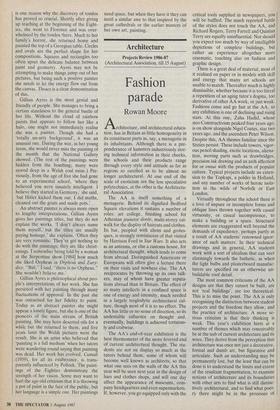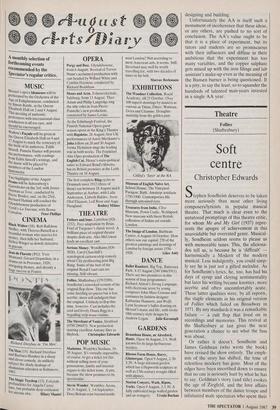Architecture
Projects Review 1986-87 (Architectural Association, till 15 August)
Fashion parade
Rowan Moore
Architecture, and architectural educa- tion, has in Britain as little homogeneity in its constituent parts as, say, a menagerie in its inhabitants. Although there is a pre- ponderance of hamsters industriously stor- ing technical information in their cheeks, the schools and their products range through every style and attitude as far as regions so rarefied as to be almost no longer architectural. At one end of the scale of exoticism are the less speculative polytechnics, at the other is the Architectu- ral Association.
The AA is itself something of a menagerie. Behind its dignified Bedford Square elevations it sustains a number of roles: art college, finishing school for Athenian jeunesse doree, multi-storey cat- walk for the display of haircuts and clothes. Its bar, peopled with aliens and grotes- ques, is strongly reminiscent of that visited by Harrison Ford in Star Wars. It also acts as an antenna, or else a customs house, for architectural thought, which tends to come from abroad. Distinguished Americans or Europeans will often give a lecture there on their visits and nowhere else. The AA reciprocates by throwing up its own talk- ers, may of whom have greater reputa- tions abroad than in Britain. The effect of so many intellects in a confined space is one of energy and intensity, much needed in a largely troglodytic architectural cul- ture, though most of it is to no effect. The AA has little or no sense of direction, so its undeniable influence on thought and, eventually, buildings is achieved tortuous- ly and crabwise.
The AA's end-of-year exhibition is the best thermometer of the more fevered end of current architectural thought. The stu- dents are not on display so much as the tutors behind them, some of whom will become well known as architects, so that what one sees on the walls of the AA this year will be seen next year in the design of bars and clothes shops, and will one day affect the appearance of museums, com- pany headquarters and even supermarkets. If, however, you go equipped only with the critical tools supplied in newspapers, you will be baffled. The much reported battle of the styles does not touch the AA, and Richard Rogers, Terry Farrell and Quinlan Terry are equally uninfluential. Nor should you expect too much by way of intelligible depictions of complete buildings, but rather an experience altogether more cinematic, touching also on fashion and graphic design.
There is a great deal of material, most of it realised on paper or in models with skill and energy that many art schools are unable to match. Thereafter much is highly dismissible, whether because it is too literal a repetition of an aging tutor's dogma, too derivative of other AA work, or just weak. Fashions come and go fast at the AA, so any exhibition is one of declining and rising stars. At this one, Zaha Hadid, whose neo-Constructivism peaked four years ago, is on show alongside Nigel Coates, star two years ago, and the ascendant Peter Wilson. Despite this, AA themes familiar since the Sixties persist. These include towers, vigor- ous pencil shading, exotic locations, aliena- tion, moving parts such as draivbridges, precision ink drawing and an arch affection for or ennui with the products of popular culture. Typical projects include an exten- sion to the Topkapi, a polder in Holland, and any number of works of heroic isola- tion in the wilds of Norfolk or East London.
Virtually throughout the school there is a love of impure or incomplete forms and oblique lines thrown together with casual virtuosity, or casual incompetence, to make a building or a space. Structural elements are exaggerated well beyond the demands of expediency, perhaps partly as a result of AA students' renowned ignor- ance of such matters. In their technical drawings and in general, AA students work with a sort of idealism that can veer alarmingly towards the bathetic, as when the light bulbs and plasterboard manufac- turers are specified on an otherwise un- buildable roof detail.
The most common criticisms of the AA designs are that they cannot be built, are not 'real buildings', are too theoretical. This is to miss the point. The AA is only recognising the distinction between student projects and the freedom they allow, and the practice of architecture. A more se- rious criticism is that their thinking is weak. This year's exhibition hints at a number of themes which may conceivably be at the nub of current architecture and its woes. They derive from the perception that architecture was once not just a decorative, formal and dumb art, but figurative and articulate. Such an understanding may be permanently lost, but the least that can be done is to understand the limits and extent
of the resultant fragmentation, to examine notions of architecture and its boundaries with other arts to find what is still distinc- tively architectural, and to find what poet- ry there might be in the processes of designing and building.
Unfortunately the AA is itself such a monument of incoherence that these ideas, or any others, are pushed to no sort of conclusion. The AA's value ought to be that it is a place of experiment, but its tutors and students are so promiscuous with their influences and diffuse in their ambitions that the experiment has too many variables, and the copper sulphate gets mixed up with the iron filings and lab assistant's make-up even as the meaning of the Bunsen burner is being questioned. It is a pity, to say the least, so to squander the hundreds of talented man-years invested in a single AA year.



















































 Previous page
Previous page